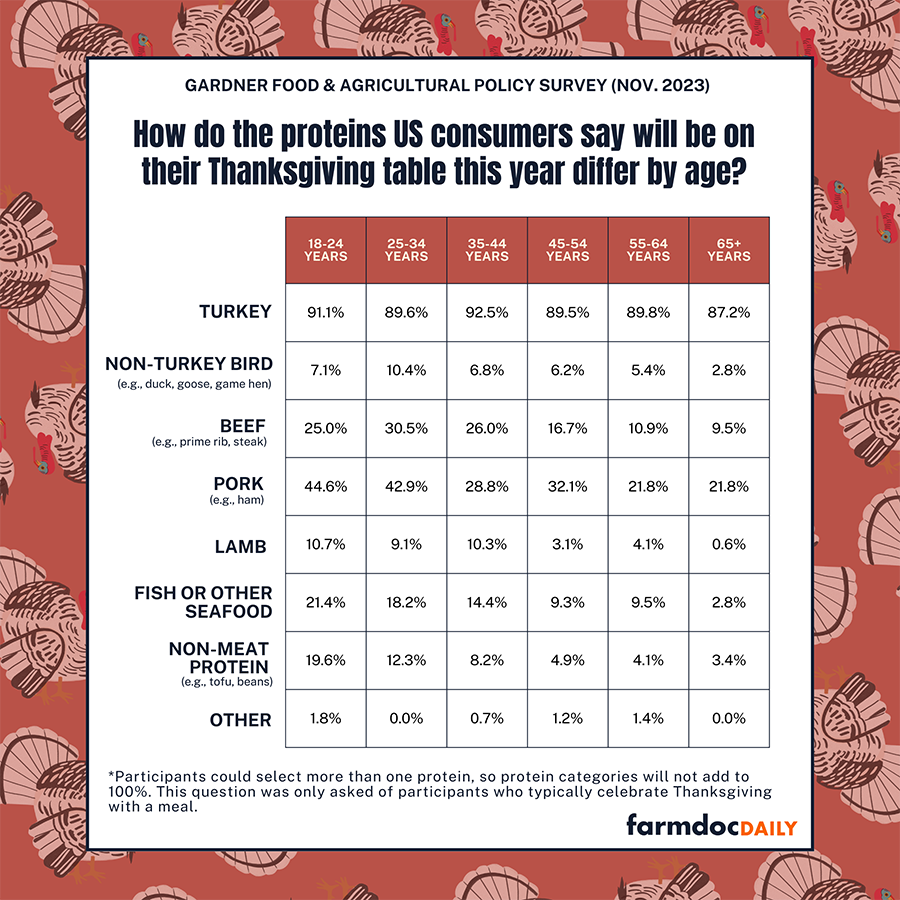Is Turkey Still King? US Consumer Protein Preferences for Thanksgiving Meals
Introduction
Thanksgiving meals often conjure up images of Norman Rockwell-esque tables piled high with big turkeys. US consumers are expected to buy 5 billion pounds of turkey in 2023 (USDA ERS, November 2023 WASDE) – and a substantial part of this demand comes in November, as a part of the country’s annual Thanksgiving holiday. But is turkey still the main dish at most Thanksgiving meals – and what other proteins do consumers serve?
In the ongoing Gardner Food and Agricultural Policy Survey, we asked 984 US consumers about their winter holiday plans. In this post, we focus on the participants who said they typically celebrate Thanksgiving with a meal (85.8%, n= 844).
Below, we explore what proteins US consumers plan to have on their Thanksgiving tables this week, and how results differ across age groups.
Results
We asked participants what proteins they expected serve for this year’s Thanksgiving meal. We find that, in keeping with tradition, turkey was the most popular protein choice – with about 90% saying they planned to have turkey at their meal. The second most common choice was pork (e.g., ham), with about 30% of participants indicating that they planned to serve pork this Thanksgiving. Other types of protein, including beef (18.8%), fish/other seafood (11.1%), lamb (5.6%), non-turkey birds (6.3%), and non-meat proteins (7.3%), were less popular.
Participants were able to select multiple proteins, to reflect the fact that sometimes consumers serve multiple types of protein for the holiday meal. On average, participants planned to have 1.7 categories of proteins.
Figure 1. Percent of Participants Who Expect to Have Different Protein Types for Thanksgiving
We also explored demand for protein across age groups. Younger consumers were less likely to celebrate Thanksgiving, and those who planned to celebrate the holiday tended to favor different proteins. The percentages of each age group reflect those who typically celebrate Thanksgiving with a meal. Younger consumers were more likely to indicate they planned to have multiple types of protein at the meal than older consumers. More specifically, we find that consumers 18-24 years old reported an average of 2.0 proteins, consumers 25-34 years old reported an average of 2.0 proteins, consumers 35-44 reported an average of 1.9 proteins, consumers 45-54 years old reported an average of 1.6 proteins, consumers 55-64 years old reported an average of 1.4 proteins, and consumers 65 years and older reported an average of 1.3 proteins.
Figure 2 shows the proportion of each age group that expected to have each protein type at their Thanksgiving meal this year. We find that although demand for turkey was quite strong across age groups – demand for other proteins differed quite a bit. In keeping with the number of protein differences across ages, younger consumers were more likely to indicate they planned to also serve other meats, including pork and beef. Plans for non-meat proteins were also much more common for younger consumers than older consumers – with 19.6% of those 18-24 indicating they planned to serve a non-meat protein at their Thanksgiving meal.
Figure 2. Percent of Participants Who Expect to Have Different Protein Types for Thanksgiving, across Age
Conclusion
Turkey is still by far the most popular protein on consumers’ Thanksgiving tables, but younger consumers are adding on more proteins to their celebrations. As a part of the ongoing Gardner Food and Agricultural Policy Survey, we found that about 90% of participants who typically celebrate Thanksgiving with a meal planned to have turkey at their meal this year, and that younger consumers were more likely to serve multiple proteins – with particularly high rates of pork (e.g., ham). Results also show that beef and non-meat proteins were popular additions to the Thanksgiving table amongst younger consumers.
Disclaimer: We request all readers, electronic media and others follow our citation guidelines when re-posting articles from farmdoc daily. Guidelines are available here. The farmdoc daily website falls under University of Illinois copyright and intellectual property rights. For a detailed statement, please see the University of Illinois Copyright Information and Policies here.









